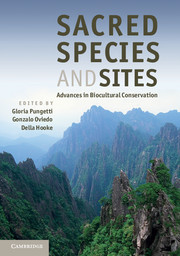Book contents
- Frontmatter
- Contents
- List of Contributors
- Foreword
- Preface
- Acknowledgements
- Introduction
- Part I Concepts and Knowledge
- Part II Sacred Landscapes
- Part III Sacred Sites and People
- 9 The landscape in the cosmoscape, and sacred sites and species among the Tanimuka and Yukuna Amerindian tribes (north-west Amazon)
- 10 Sacred natural sites in zones of armed conflicts: the Sierra Nevada de Santa Marta in Colombia
- 11 Struggles to protect Puketapu, a sacred hill in Aotearoa
- 12 The Roman goddess Care: a therapy for the planet
- Part IV Sacred Species
- Part V Sacred Animals
- Part VI Sacred Groves and Plants
- Part VII Implementation and Conclusions
- Index
- Plate Section
- References
9 - The landscape in the cosmoscape, and sacred sites and species among the Tanimuka and Yukuna Amerindian tribes (north-west Amazon)
from Part III - Sacred Sites and People
Published online by Cambridge University Press: 05 August 2012
- Frontmatter
- Contents
- List of Contributors
- Foreword
- Preface
- Acknowledgements
- Introduction
- Part I Concepts and Knowledge
- Part II Sacred Landscapes
- Part III Sacred Sites and People
- 9 The landscape in the cosmoscape, and sacred sites and species among the Tanimuka and Yukuna Amerindian tribes (north-west Amazon)
- 10 Sacred natural sites in zones of armed conflicts: the Sierra Nevada de Santa Marta in Colombia
- 11 Struggles to protect Puketapu, a sacred hill in Aotearoa
- 12 The Roman goddess Care: a therapy for the planet
- Part IV Sacred Species
- Part V Sacred Animals
- Part VI Sacred Groves and Plants
- Part VII Implementation and Conclusions
- Index
- Plate Section
- References
Summary
Introduction
This chapter investigates the relevance of the Tanimuka and Yukuna notions that landscape dynamics are composed of horizontal linkages between peoples and habitats, and also of vertical linkages connecting peoples with the skies, world and underworlds through material and spiritual dynamics. It examines how sacred sites and species in rainforests and in swidden and anthropogenic landscapes are used to monitor socio-environmental well-being, and how they are used as references to shamanically negotiate and calibrate human existence with the supra-natural forces and ‘Guardian Spirit/Owners’ (henceforth called Guardians) of the rainforests and with other Guardians of the planet and universe. It discusses how, according to the shamanic cosmologies of the Tanimuka and Yukuna, the sacred sites and species are associated with events related to the origin, evolution and destiny of their societies, and to the rest of humanity, life, the world and the universe, and inquires how the ethno-eco-cosmic linkages pass through the sacred sites and species connecting the landscape to the cosmoscape. While indicating how this shamanic framework assesses synergies between humans and the rest of the biosphere, world and cosmos, this chapter explains how this system is applied by the Tanimuka and Yukuna to enhance socio-environmental resilience.
The Colombian Amazon and indigenous peoples
The Amazon rainforest exists in nine countries, of which Colombia is one. For the last 11 000 years, indigenous peoples have inhabited Amazonia while developing a large diversity of cultures, languages and resource management strategies. During the past five centuries, the Amerindians have been impacted by genocide, ethnocide and environmental degradation accompanying the expansion of non-indigenous societies. More recently, the accrued destruction of Amazonia with deforestation, habitat degradation and unsustainable exploitation of natural resources have been threatening traditional Amerindian cultures and their sound ways of safeguarding the rainforests.
- Type
- Chapter
- Information
- Sacred Species and SitesAdvances in Biocultural Conservation, pp. 127 - 151Publisher: Cambridge University PressPrint publication year: 2012
References
- 1
- Cited by

